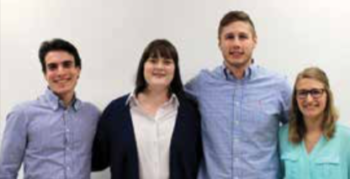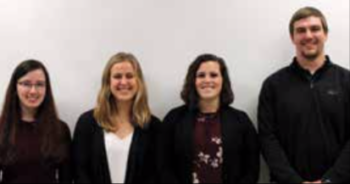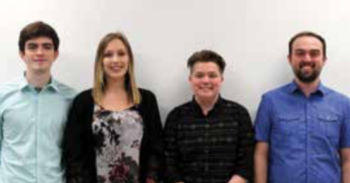Biosystems Engineering student teams, enrolled in the two-semester biosystems design capstone experience, BE 485/487, develop, evaluate, and select design alternatives in order to solve real-world problems. Projects are diverse, but each reflects systems thinking by integrating interconnected issues affecting the problem, including critical biological constraints. The engineering design process is documented in a detailed technical report. Teams present project designs to engineering faculty and a review panel of professional engineers for evaluation. Each BE 485/487 capstone design team prepares and presents a design solution in report, poster and oral formats to an industry advisory board, faculty, peers and the public that:
- Requires engineering design
- Uses a holistic approach
- Combines biology and engineering
- Interprets data
- Solves a real problem
- Evaluates economic feasibility
For information on sponsoring a project, please contact Dr. Dana Kirk or Dr. Luke Reese.
Biosystems Engineering students participate in Spring Term Design Day. The following were the project sponsors and projects for the Spring of 2019:
Super Modelers: Improving Potato Storage Ventilation with a Computational Fluid Dynamics Model

Super Modelers developed a computational fluid dynamics (CFD) model to study airflow characteristics in Techmark’s Riverdale potato storage facility. This model was used to identify the cause of non-uniform aeration to the facility’s potato pile, and recommend improvements to the air distribution systems. Uniform airflow to the potatoes is critical to ensure optimal temperature and humidity during storage. Upon completion of this project, Techmark will have an airflow model they can apply to future storage facility design work, and design recommendations supported by the model.
Sponsor – Techmark, Inc.
Faculty Advisor – Dr. Wei Liao, PE
Team Members (L-R): Samuel Effa, Christopher Robbe, Jacob Duckworth, & Jessica Schultz
Invasive Crustacean Eradication: Red Swamp Crayfish Control Plan Using Acoustic Stimuli
An infestation of Red Swamp Crayfish (Procambarus clarkii) was reported in 2015 in southeast Michigan. The invasive species has since spread. Invasive Crustacean Eradication was tasked to find an engineering solution to contribute to the MDNR’s population control plan. Auditory stimuli were found to influence crayfish motility through experimental trials. Pure tones, white noise, and pink noise were tested to determine
the most effective stimuli. A trap was retrofitted to utilize a sound system resulting in increased trapping rates.
Sponsor – Michigan Department of Natural Resources
Faculty Advisors – Dr. Wei Liao, PE
Team Members (L-R): Xiaojing Ma, Douglas Clements, Henry Frost & Megan Beaver
Energy Efficienados: Manufacturing Chiller Operation Optimization

The Energy Efficienados partnered with Perrigo’s Plant 4, a pharmaceutical manufacturing facility in Allegan, Michigan. The team was tasked with developing a chiller staging scheme in hopes of reducing the plant’s energy consumption and environmental footprint in conjunction with the corporate goal of reducing greenhouse gas emissions, water
and energy usage by 15% in 2020. The team utilized a variety of tools such as MatLab and Excel to develop the chiller staging scheme. The staging scheme takes advantage of higher chiller efficiency at partial load as compared with full load and ensures chillers are operated in a manner that leads to reliability and a long life.
Sponsor – Perrigo (project under NDA agreement)
Faculty Advisor – Dr. Aluel Go & Dr. Truman Surbrook
Team Members (L-R): Matthew Schweiss, Brittany Esser, Karoline Russek, & Seung Lee
The Rot Roasters: Brown Kernel Rot Treatment System for Post-harvest Chestnuts

In the chestnut industry, emerging pathogens that cause nut rot are becoming a problem. The Rot Roasters designed a continuous-flow heat treatment system to reduce the incidence of one specific pathogen, Gnomoniopsis Castaneae, which causes brown kernel rot. The team performed an experimental study to validate the treatment efficacy and designed a 5,000 lb/hr throughput hot water blanching system. This system will reduce the growth of rot during cold storage, maintaining the quality of Chestnut Growers, Inc.’s fresh chestnut product.
Sponsor – Chestnut Growers, Inc.
Faculty Advisor – Dr. Dan Guyer
Team Members (L-R): Matt Kay, Brigit Culkeen, Brandon Dulaney, & Rebecca Jones
Trommel Cleaners: Trommel Cleaning System Enhancement
Clean processing equipment is critical in the food industry to ensure a safe, quality product to the consumer. Large industrial sized trommels are essential for corned beef production; however, they are labor-intensive to clean. To reduce cost and improve ergonomics, it is essential that Grobbel’s cleaning process is fast, efficient, and effective. Trommel Cleaners was tasked with enhancing the trommel cleaning system to reduce the resources required for cleaning. With the team’s design, yearly operating costs for trommel cleaning are reduced by over 30%.
Sponsor – Grobbel’s
Faculty Advisor – Dr. Susie Liu
Team Members (L-R): Chris Rybinski, Kyle Forbush, Kennedy Coxon & Jack Blackhurst
The Canal Pals: Sediment Management to Support Boat Traffic

The Grand Pointe Subdivision in Dimondale, Michigan consists of 87 homes, surrounding 5 man-made canals. Sediment build-up in the canals has restricted access of large boats to the Grand River through the canal entrances. The Canal Pals were tasked with finding a long-term solution for reducing the rate of sediment accumulation in the canals. The team designed a sediment trap as a local solution and recommended agricultural Best Management Practices as upstream solutions to reduce sediment load depositing in the canals.
Sponsor – Grand Pointe Homeowner’s Association
Faculty Advisor – Dr. Ehsan Ghane
Team Members (L-R): Sarah Skinner, Lindsey Defrain, Elizabeth Walls & Tyler Lahusky
Ernie’s Engineers: Red Swamp Crayfish Control in Michigan

Kellogg’s production of sandwich-style cookies and crackers is the cause of significant downtime and lost product resulting in economic loss. Ernie’s Engineers examined the process line to determine the areas of highest product loss. The design improvement recommendations, based on this data collection, will enhance the system with upgraded technology while maintaining production rates and complying with food safety regulations.
Sponsor – Kellogg (project under NDA)
Faculty Advisor – Dr. Ilce Medina Meza & Dr. Kirk Dolan
Team Members (L-R): Craig Campbell, Nicole Urrea, Linnea Riddell & Katie Church
Partners in Wine: Adsorption Media Contact System for Michigan Winery Wastewater Treatment
Michigan winery wastewater has high concentrations of ammonia and soluble phosphorus. Treatment of this wastewater prior to discharge is required to meet state regulations defined under Rule 22, Groundwater Quality. Traditional treatment approaches for winery wastewater are often land intensive. Partners in Wine designed additions and modifications to a gravel vertical flow contactor to achieve regulatory treatment levels of ammonia and soluble phosphorus in winery wastewater for facilities producing between 5,000 and 25,000 cases per year. The final design was a compact constructed wetland system that reduces land required for treatment by 80% when compared to common land application methods.
Sponsor – Michigan Craft Beverage Council
Faculty Advisors – Dr. Steve Safferman, PE
Team Members (L-R): Thiramet Sotthiyapai, Jessica Hauda, Katelyn Skornia & Corrine Zeeff
Get Out Of Weir: Master Plan for Red Cedar Weir Removal

MSU is interested in preparing a master plan for the restoration of the Red Cedar River. As part of the preparation, “Get Out Of Weir” developed a plan for the weir located south of the Administration Building. The recommended design improves the environmental quality and diversity of the river, decreases the chances of flooding, protects threatened species, and opens the river for recreational enjoyment. The final design replaces the weir with rock arch rapids. The report includes a feasibility study, a HEC-RAS hydrologic model, cost analysis, permits required, and potential funding sources.
Sponsor – GEI Consultants
Faculty Advisors – Dr. Steve Safferman, PE
Team Members (L-R): Cody Howard, Brittany Macintyre, Sam Rolling & Matt Champion
Peer Energy: Peer Verification Process for Livestock Anaerobic Digester Carbon Offsets
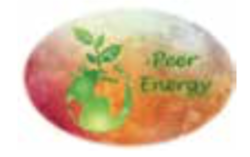
Super Modelers developed a computational fluid dynamics (CFD) model to study airflow characteristics in Techmark’s Riverdale potato storage facility. This model was used to identify the cause of non-uniform aeration to the facility’s potato pile, and recommend improvements to the air distribution systems. Uniform airflow to the potatoes is critical to ensure optimal temperature and humidity during storage. Upon completion of this project, Techmark will have an airflow model they can apply to future storage facility design work, and design recommendations supported by the model.
Sponsor – Duke University Carbon Offsets Initiative
Faculty Advisor – Dr. Dana Kirk, PE
Team Members (L-R): Amanda Godar, Maria Barrios Arosemena & Julia Guzy (Not pictured Nina Dermody)
Probiotic Pros: Assay Development for Evaluation of On-farm Probiotic Application
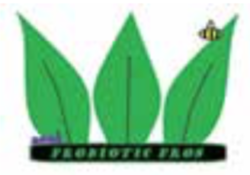
Probiotic Pros has developed an assay to quantify viable Bacillus subtilis in agricultural soils after probiotic application. Quantification is necessary for farmers to observe the presence of B. subtilis pre- or post- application and after extreme weather events. First, a screening for B. subtilis DNA using a colorimetric gold nanoparticle assay was performed. Then, B. subtilis was quantified using viability PCR (vPCR), which involved the removal of non-viable DNA from the sample before quantitative PCR is performed. The team designed a kit with guidelines and materials for farmers to sample their soil for the assay.
Sponsor – Dr. Larry Walker
Faculty Advisors – Dr. Darrell, PE & Dr. Timothy Harrigan
Team Members (L-R): Alex Hernandez, Jill Check, Tess Cannon & Jenna Baughman
Cold Hardy Greens: Manufacturing Chiller Operation Optimization

The Energy Efficienados partnered with Perrigo’s Plant 4, a pharmaceutical manufacturing facility in Allegan, Michigan. The team was tasked with developing a chiller staging scheme in hopes of reducing the plant’s energy consumption and environmental footprint in conjunction with the corporate goal of reducing greenhouse gas emissions, water
and energy usage by 15% in 2020. The team utilized a variety of tools such as MatLab and Excel to develop the chiller staging scheme. The staging scheme takes advantage of higher chiller efficiency at partial load as compared with full load and ensures chillers are operated in a manner that leads to reliability and a long life.
Sponsor – Perrigo (project under NDA agreement)
Faculty Advisor – Dr. Aluel Go & Dr. Truman Surbrook
Team Members (L-R): Carly Drobny, Jamison Midgley, David Chickering & Kody Carpenter
Peru Crew: Antibiogram-Biosensor Design to Rapidly Detect Antibiotic Resistant Bacteria

Carbapenem resistant Enterobacteriaceae (CRE) are an emerging threat to patients in healthcare settings. Currently, physicians in Peru do not have an efficient method to test if bacteria strains isolated from patients in their hospitals are antibiotic resistant, so they potentially overprescribe multiple antibiotics while awaiting test results. This can lead
to progression of infection, proliferation of antibiotic resistant bacteria, and expensive treatments for low-income patients. Peru Crew developed a low-cost biosensor to rapidly detect antibiotic resistance in K. pneumoniae, a type of CRE often isolated from patients in the clients’ hospitals.
Sponsor – Dr. Alex Castañeda Sabogal & Dr. Ruben Kenny Briceno
Faculty Advisor – Dr. Evangelyn Alocilja
Team Members (L-R): Carly Gomez, Nathan Dickinson, Jeanelle Grosvenor & Cayla Harrison





